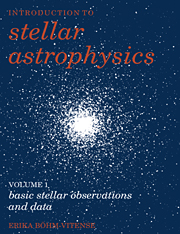Book contents
- Frontmatter
- Contents
- Preface
- 1 Positions of stars
- 2 Proper motions of stars
- 3 Distances of nearby stars
- 4 The brightnesses of the stars
- 5 Color magnitude diagrams
- 6 The luminosities of the stars
- 7 Angular radii of stars
- 8 Effective temperatures of stars
- 9 Masses and radii of stars
- 10 Spectral classification
- 11 Understanding stellar spectra
- 12 Population II stars
- 13 Stellar rotation
- 14 Stellar magnetic fields
- 15 Stars with peculiar spectra
- 16 Pulsating stars
- 17 Explosive stars
- 18 Our sun
- 19 Interstellar absorption
- Appendixes
- References
- Index
5 - Color magnitude diagrams
Published online by Cambridge University Press: 04 August 2010
- Frontmatter
- Contents
- Preface
- 1 Positions of stars
- 2 Proper motions of stars
- 3 Distances of nearby stars
- 4 The brightnesses of the stars
- 5 Color magnitude diagrams
- 6 The luminosities of the stars
- 7 Angular radii of stars
- 8 Effective temperatures of stars
- 9 Masses and radii of stars
- 10 Spectral classification
- 11 Understanding stellar spectra
- 12 Population II stars
- 13 Stellar rotation
- 14 Stellar magnetic fields
- 15 Stars with peculiar spectra
- 16 Pulsating stars
- 17 Explosive stars
- 18 Our sun
- 19 Interstellar absorption
- Appendixes
- References
- Index
Summary
Color magnitude diagrams of nearby stars
For nearby stars, say within 20 pc, we can determine the distances from trigonometric parallaxes. From the apparent magnitudes and the distances we can calculate the absolute magnitudes, i.e., the magnitudes which the stars would have if they were at a distance of 10 pc. This means that for absolute magnitudes we compare the brightness the star would have if it were at a distance of 10 pc with the actual brightness of Vega at its actual distance, i.e. with its apparent brightness. It turns out to be quite instructive to plot the absolute magnitudes of the stars as a function of their B – V colors. In Fig. 5.1 we do this for the nearby stars. While we might have expected that stars with a given color could have quite different absolute magnitudes, it turns out that this is generally not the case. Most of the stars with a given B – V color have the same absolute magnitude. Most of the stars fall along one line in the color magnitude diagram. This line is called the main sequence. The intrinsic brightnesses and the colors of these stars are obviously determined by just one parameter, since they follow a one-dimensional sequence. It turns out, as we shall see in Volume 3, that this one parameter is the mass of the star.
- Type
- Chapter
- Information
- Introduction to Stellar Astrophysics , pp. 31 - 40Publisher: Cambridge University PressPrint publication year: 1989

